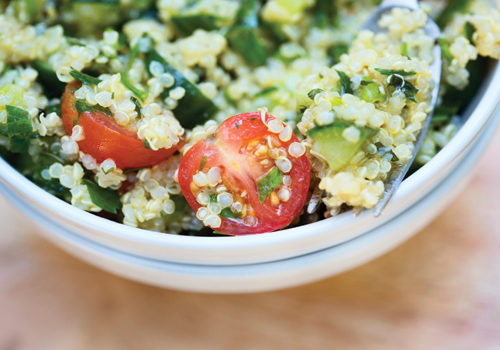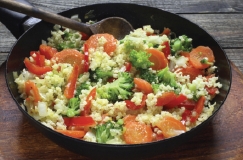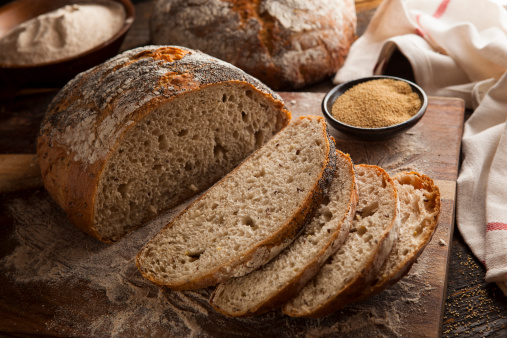What’s old has become new with ancient grains capturing the attention of shoppers nationwide. From freekeh to millet, Americans see the value of ancient grains in their diets, and manufacturers are responding with exciting offerings.
“The popularity of ancient grains has been explosive in the last few years, with foods like quinoa, chia and lentils moving from niche to conventional appeal,” states Cricket Allen, founder of The Perfect SNAQUE, Hamilton Township, NJ. “We embrace the pledge and push for healthy eating.”
1. Quinoa
Perhaps the most popular standout ancient grain (technically an ancient seed) is quinoa. Wendy Esko, director of marketing research at Eden Foods, Clinton, MI, calls it “the most ancient American staple grain.” Material prepared by Esko’s company highlights the way the grain supports small communities: 95% of the world’s quinoa is grown on small family farms at an elevation of over 12,500 feet in the Andes Mountains. Other quinoa is harvested by small communities in Bolivia and elsewhere.
From a nutritional standpoint, the grain gets high marks from the Food and Agricultural Organization and the World Health Organization, Esko says. The group rated this gluten-free, wheat-free grain as having a protein quality similar to milk casein. It’s also a good source of fiber, iron and the B-vitamins.
Allen says her company uses quinoa and lentils in its products because “they provide exceptional and intrinsic nutritional value, texture and taste. We want every bite to count!”
She adds that quinoa possesses all nine essential amino acids and it is a slow-digesting carb, “meaning that it keeps you full longer and doesn’t spike your blood sugar as processed, white starchy carbs do.”
The grain is also versatile, and makes a good addition to cold and hot salads, veggie burgers and soups or even served as a hot breakfast cereal. One company (Factoría Quinoa) is even bringing quinoa into the supplements channel with a nutritional powder that can be added to smoothies, drinks and even baby food for extra protein, amino acids and other nutrients.
2. Mesquite Flour
Mesquite flour? Yes, that’s right, the famous southwestern flavor has far more applications.
While not a grain, this ancient meal has a unique aroma and flavor that resembles mocha coffee, cinnamon and chocolate. The flour is naturally gluten free and can be used to make gluten-free and conventional pastries, waffles, dairy desserts and more, according to Peter Felker of Casa de Mesquite, Hollister, CA.
There are some unique health benefits, too. The company says mesquite flour has more protein and dietary fiber than rice or manioc flour. It also has high fiber content, and is moderately high in antioxidant activity.
3. Millet
According to Esko, millet is “one of the oldest human foods and believed to be the first domesticated cereal grain.” She says it ranks as the sixth most important cereal grain in the world because it sustains one-third of the world’s population.
Esko says the popularity of this grain is understandable, since it’s “nutritious, quick cooking, whole grain; it is gluten-free and a versatile grain.” It’s also a great source of magnesium, making it a good choice for those looking for heart and blood sugar support (1).
If shoppers feel like this grain is just birdseed (it’s actually a main ingredient in bird seed), tell them about its many uses. For starters, it can be boiled and made fluffy like rice or porridge. Ground versions are suitable for use in making flatbreads, muffins and breads; this latter use is even referenced in the Bible (2)!
4. Spelt
Spelt was a staple bread wheat in Europe and the Middle East until it was displaced by modern, hybrid wheat, says Esko, though it is still a major food crop in countries like Germany and Italy. Esko explains that spelt has a hull that is difficult to remove from the grain, but that this hull “is an asset through protecting it from insects and pollutants, while helping it retain nutrients, moisture, and freshness in storage.”
 Don Stinchcomb, president of Purity Foods, Inc., Hudson, MI, expands on this important info about spelt: it may be a good choice for people with certain wheat sensitivities.
Don Stinchcomb, president of Purity Foods, Inc., Hudson, MI, expands on this important info about spelt: it may be a good choice for people with certain wheat sensitivities.
He says at the 2013 Celiac Symposium held at the University of Chicago, “researchers agreed that many of the people who found relief in gluten-free diets were not celiac, but found relief because wheat has amylase and protease inhibitors that block the enzymatic breakdown of the wheat seed.”
He says that spelt doesn’t have these inhibitors (needed by the plant to protect the kernel from insects) because of its unique hull and may be suitable for people with sensitivities. “Once we began marketing the product, we had thousands of consumers with wheat sensitivities and inflammatory illnesses contact us to say, ‘Thank God for you guys; you changed my life,’” he states. “It was then that my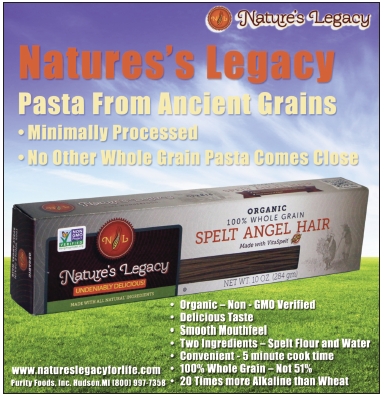 quest began to try and determine what was so unique about spelt that it elicited such a response. It took years and many blind alleys, but I think I have finally discovered the secret.” His company turns spelt into pastas and other products.
quest began to try and determine what was so unique about spelt that it elicited such a response. It took years and many blind alleys, but I think I have finally discovered the secret.” His company turns spelt into pastas and other products.
5. Khorasan
Native to Egypt, Khorasan wheat, according to Esko, has the “highest protein of all wheat; because its protein is easy to digest, those with sensitivity to modern wheat often find they can enjoy Khorasan wheat.”
One branded form of this wheat, Kamut (from Kamut International) was one of the first in the U.S. market. Bob Quinn, founder of Kamut International, states, “I had an idea to introduce it to the health food industry at a food show in 1986 as a novelty. As products were introduced, we continued to be surprised and amazed at the reports that were first complimentary on taste and texture and then came reports from those who had trouble eating modern wheat but no trouble eating our ancient wheat.”
Esko says the ancient wheat can be used to make whole grain pasta and rolled cereal flakes.
According to Quinn, studies show that the grain produces a higher antioxidant capacity than modern wheat when it is consumed. In addition, he says, “the ancient grain is anti-inflammatory while modern wheat causes inflammation. In the case of irritable bowel syndrome, we saw an improvement in symptoms in every individual from 50% to 100% when they ate ancient wheat products compared to modern wheat products.”
6. Amaranth
Amaranth was cited by several interviewees as a grain to watch. “Amaranth may fall just short of being a complete protein, unlike quinoa, but it boasts plenty of nutrients, including lysine, one of the key essential amino acids that is missing in most grains,” says Constance Roark, registered dietitian and director of marketing for Ancient Harvest, Boulder, CO.
Information from Late July, Barnstable, MA, suggests that fiber-rich amaranth is a complete source of protein and contains iron, magnesium and essential amino acids like lysine.
7. Chia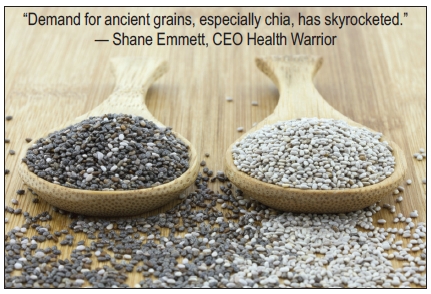
Chia, an ancient seed, offers a wide array of benefits, one of the best known being for sustained energy. This was how Shane Emmett, CEO of Health Warrior, Richmond, VA, was introduced to chia. He and his company’s cofounders had read about an isolated tribe of Indians in northern Mexico that can run 50–100 miles at a time eating not much more than beans, maize tortillas and chia seeds. “Fascinated, we began eating chia and were amazed by the strength it added to our workouts,” he states. “We created the Chia Bar to be an easy way to eat this amazing food on-the-go.”
Chia is said to be the richest plant source of omega-3s such as ALA, and is packed with fiber, protein, vitamins and minerals. Some human clinical trials suggest that eating chia supports healthy blood sugar levels and heart health, and helps support satiety.
8. Freekeh
Soup, pilafs, salads…freekeh is a great addition to many dishes. “Freekeh has been around for several thousand years, however it is little known in the United States,” states Troy De Smet, founder and president of Freekeh Foods, Forest Lake, MN.
This nutty, chewy grain originated in the Middle East, where legend says one village’s green wheat was burned during an attack. The townspeople rubbed off the chaff (freekeh means “to rub” in Arabic), cooked it and the rest is history.
This grain is more than just taste. “One of the reasons we chose to work with organic freekeh is due to its exceptional nutritional properties,” says De Smet. “We believe that providing a whole grain that is high in protein and fiber, that is versatile in dishes, and that is ecologically sustainable is a great choice for consumers.”
There are too many tasty and beneficial ancient grains to fully discuss here. Others include buckwheat, which is wheat and gluten free and provides protein, amino acids, vitamin C, minerals and fiber; authentic wild rice, which is harvested by hand in a canoe by Native Americans; rye, which offers “complete protein containing all the amino acids, including the essential ones,” according to Esko; sprouted lentils, which offer protein, fiber and iron; teff, which Jill Motew, founder and president of Zemas Madhouse Foods, Highland Park, IL, says has a mild flavor that pairs well with many foods; fiber-packed dulse; and sorghum, which is gluten free, rich in antioxidants and full of policosanol.
Smart Combos
Several companies choose to combine the benefits of several grains in their products. For instance, Late July’s multigrain tortilla chips use a blend of five ancient grains and seeds (organic quinoa, organic amaranth, organic millet, organic flax and organic chia) because of their “great taste and added nutritional benefits including fiber, omega-3s and antioxidants.”
|
Web Exclusive: Ancient Grains Recipes Breakfast quinoa? Millet mashed potatoes? Kamut pancakes? Check out some incredible ancient grain recipes here: |
For the same reason, Mary Waldner, founder and chairman of Mary’s Gone Crackers, Gridley, CA, says her company chose to use quinoa, amaranth, millet, chia, flax and sesame “for taste and nutritional content and because they are gluten free.”
Meanwhile, Motew says Zemas uses teff, millet, sorghum, dedicated gluten-free oat flour, quinoa and superseeds chia, hemp and flax meal. “We carefully chose these grains to support a healthy, clean, non-GMO eating lifestyle that also contains a positive nutrient profile,” Motew states. “Each ancient grain we use supports whole body health in some way (brain function, metabolism, even blood sugar levels, inflammation and antioxidants).”
Ancient Grains: Here Today, Gone Tomorrow?
As ancient grains come to the forefront, could there be shortages that come with the increased popularity?
“We are in the midst of a supply problem at this time and look toward bigger supply issues over the next 14 months,” says Stinchcomb. Part of the problem stems from the incredible demand for corn. “Most crops are priced in relation to corn. If corn brings in more dollars per acre, then a farmer has to be committed to sustainable agriculture and be sold on the philosophy of crop rotation; otherwise he will just plant corn,” he explains.
Since few farmers would sacrifice dollars for crop rotation (and yes, Stinchcomb says most seed for specialty crops is grown on conventional farms), companies must pay a higher price per acre (and pass increases onto consumers) or the seed does not get planted.
“With new varieties of corn that have been developed for marginal areas, the search for seed growers for specialty crops has become increasingly difficult,” Stinchcomb believes.
Quinn’s company takes matters into its own hands on this front: “We have an aggressive program to promote and help increase the conversion of chemical farms to organic production systems so that we can keep up with the growing demand.”
Waldner has a different take. She says like all commodities, the supply fluctuates from time to time due to weather and demand. “Our experience is that farmers will grow what manufacturers want and if there is a limited supply it generally doesn’t last very long,” she states.
Some suppliers are taking proactive approaches to ensure enough supply is available, should there be a spike in demand or a growing disaster. Quinn says his company searches all over the planet for the best places to grow Kamut brand khorasan wheat. “At this time, most of it is grown on North America’s Northern Great Plains,” he states. “We try to plant more than we expect to sell each year and build up a buffer that can help us through years of poor crops and excess demand.”
Now, should ancient grains shoppers lose sleep over the possibility of GMO contamination? Allen states, “It is worrisome that smaller farms in the United States and beyond may be presented with incentives to compromise their organic and/or non-GMO commitments.” She adds that many of the shoppers who are hungry for ancient grains are also hungry for non-GMO, and are often the ones pushing for non-GMO legislation. “If these consumers stand by this pledge, I feel the risk is mitigated,” she states.
Emmett agrees, saying, “As more people learn about chia and GMO, I think there will be great pressure from advocates and the general population to keep products as they are—the same as when the Aztec warriors ate them.”
|
Select Ancient Grains Offerings
Ancient Harvest: Culinary Ancient Grains (Sea Salt and Herb, Butter and Parmesan, Spanish Style, Spicy Curry) and Quinoa (Traditional, Inca Red and Harmony). Eden Foods: Organic EDEN Quinoa, Organic EDEN Red Quinoa, Organic EDEN Buckwheat, Organic EDEN Millet, EDEN Wild Rice, Organic EDEN Kamut Flakes, Organic EDEN Spelt Flakes, Organic EDEN Rye Flakes, Organic EDEN Kamut & Buckwheat Rigatoni, Organic EDEN Kamut Ditalini, Organic EDEN Kamut Elbows, Organic EDEN Kamut Spaghetti, Organic EDEN Kamut Spirals, Organic EDEN Kamut Vegetable Spirals, Organic EDEN Kamut & Quinoa Twisted Pair, Organic EDEN Rye Spirals, Organic EDEN Spelt Spaghetti, Organic EDEN Spelt Ribbons, Organic EDEN Spelt & Buckwheat Gemelli, Organic EDEN Spelt Ziti Rigati, Organic EDEN Müesli, Organic EDEN Cinnamon Müesli, Organic EDEN Spelt Soba, Organic EDEN Spelt Udon, Organic EDEN Kamut Soba, Organic EDEN Kamut Udon. Factoría Quinoa: Quinoasure and Andes Quinoagrain. Freekeh Foods: Three varieties of Organic Freekeh, as well as Freekeh Flour, and Freekeh Pasta. Health Warrior: Health Warrior Chia Bars in eight flavors. Health Warrior Chia Seeds in both White and Black varieties. Late July: Late July Organic Restaurant Style Chia & Quinoa Tortilla Chips, Late July Organic Sea Salt by the Seashore Multigrain Tortilla Chips, Late July Sub Lime Multigrain Tortilla Chips, Late July How Sweet Potato It Is Multigrain Tortilla Chips, Late July Summertime Blues Multigrain Tortilla Chips, Late July Red Hot Mojo Multigrain Tortilla Chips, Late July Dude Ranch Multigrain Tortilla Chips, Late July Mild Green Mojo Multigrain Tortilla Chips. Mary’s Gone Crackers: Seven flavors of our Seed Crackers: Original, Herb, Black Pepper, Caraway, Onion, Hot ‘n Spicy Jalapeno, and Super Seed. The Perfect SNAQUE: Coconut Almond Quinoa Crunch, Cinnamon Apple Quinoa Crunch, Apple Quinoa Crunch, Sea Salt & Vinegar Sprouted Lentils, Honey Mustard Sprouted Lentils, Cinnamon Sugar Sprouted Lentils, Berry Skinny Trail Mix with Sprouted Lentils, Skinny Trail Mix with Sprouted Lentils. Purity Foods, Inc.: Products marketed under the Nature’s Legacy for Life and Vita Spelt brand names. Spelt-based pastas and flour and emmer-based grain and flours. Zemas Madhouse Foods: Seven gluten-free baking mixes with ancient whole grains that include a muffin mix, cookie mix and pancake and waffle mixes. |
But, Stinchcomb believes “true ancient grains” are unlikely to become contaminated with any of the current GMO crops in production, especially anything that could intermingle with wheat. “The U.S. Department of Agriculture has not green-lighted wheat and I don’t believe other ancients are in a genus that would be impacted with GMO contamination,” he says. The good news is that wheat is self-pollinating and not cross-pollinating like corn, Quinn explains, “so we will not need to worry about pollen drifting from GMO crops and contaminating our non-GMO wheat, but we will need to worry about contamination in the handling systems.”
Quinn says that since his company’s ancient khorasan wheat is branded, the firm has great control over the supply and manufacturer. He states, “The trademark guarantees that the KAMUT brand products will always contain ancient wheat that is 100% organically grown, high quality and 100% pure khorasan wheat.” Quinn says his company’s crop is protected in some ways because its grain is organic and is about twice the size of modern wheat, making contamination very visible.
Nonetheless, he believes Americans should pay attention to the biotech industry’s attempts to get genetically engineered wheat approved for growth and sale in this country. States Quinn, “If the general public allows this to happen, then we will have to be very vigilant to prevent contamination.”
Some grains have a bit of a GMO shield. Esko explains that authentic wild rice is “hand harvested by canoe as required by law and protected from genetic modification by law.”
Similarly, she says that the red pasankalla variety of quinoa is unlikely to face an issue with GMO contamination. She states, “the farmers in the Intersalar area of ‘Salar de Uyuni’ (Uyuni Salt Flats in Bolivia) follow strict guidelines to preserve this grain’s identity and traditional farming practices of the area; their quinoa DNA has remained pure for centuries and is protected from modern hybrid and genetically engineered varieties.”
Roark says here in Bolivia, where her firm also sources its quinoa, only 120,000 hectares (one hectare equals about 2.5 acres) out of an available four million hectares for quinoa farming are being used. “We want to provide them with what they need to yield a good organic quinoa crop and continue to farm sustainably, which ultimately contributes to their quality of life and protects the integrity of their land,” she states.
Of course, there is always the risk of an unscrupulous vendor milling an ancient grain with another grain for cost reasons. Therefore, using top-notch suppliers is always the way to go. Or choose a company whose products are Non-GMO Project Verified. Motew says her company chooses to go this route.
So what about ancient grains and gluten-free choices? States Lola O’Rourke, M.S., R.D., education manager at the Gluten Intolerance Group, Auburn, WA, “Increasing availability of ancient grains is terrific for gluten-free consumers since so many are naturally gluten free. But there can be risk of cross-contamination with gluten.”
Therefore, she suggests that one choose products that are labeled gluten-free and certified gluten-free by the Gluten-Free Certification Organization. She adds “teff, sorghum and millet are excellent, versatile options for gluten-free consumers.” She states they can be prepared either sweet (like topped with fruit for breakfast) or savory (prepared with broth and spices). “Flours made from these grains work well in a wide variety of baked goods and desserts,” she adds. WF
References
1. World’s Healthiest Foods, www.whfoods.com/genpage.php?tname=foodspice&dbid=53, accessed May 22, 2014.
2. Eden Foods, www.edenfoods.com/articles/view.php?articles_id=122, accessed May 22, 2014.
Published in WholeFoods Magazine, July 2014

